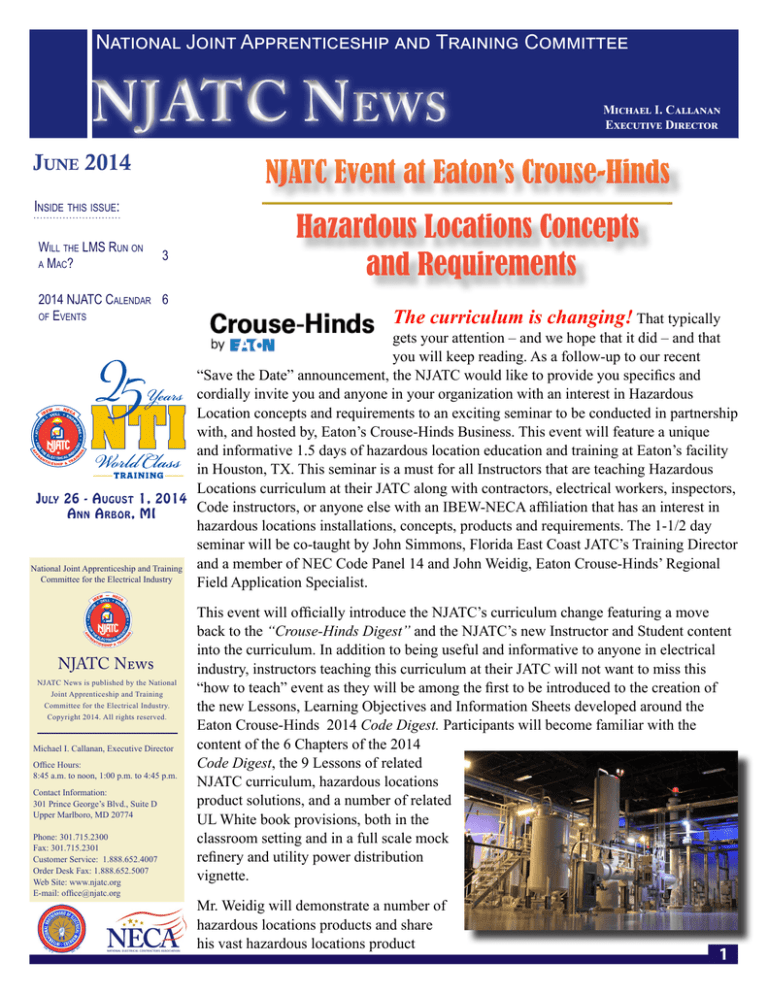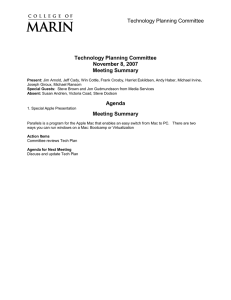
National Joint Apprenticeship and Training Committee
NJATC News
June 2014
NJATC Event at Eaton’s Crouse-Hinds
Inside this issue:
Will the LMS Run on
a Mac?
Michael I. Callanan
Executive Director
3
2014 NJATC Calendar 6
of Events
Hazardous Locations Concepts
and Requirements
The curriculum is changing! That typically
gets your attention – and we hope that it did – and that
you will keep reading. As a follow-up to our recent
“Save the Date” announcement, the NJATC would like to provide you specifics and
cordially invite you and anyone in your organization with an interest in Hazardous
Location concepts and requirements to an exciting seminar to be conducted in partnership
with, and hosted by, Eaton’s Crouse-Hinds Business. This event will feature a unique
and informative 1.5 days of hazardous location education and training at Eaton’s facility
in Houston, TX. This seminar is a must for all Instructors that are teaching Hazardous
Locations curriculum at their JATC along with contractors, electrical workers, inspectors,
J uly 26 - A ugust 1, 2014
Code instructors, or anyone else with an IBEW-NECA affiliation that has an interest in
A nn A rbor , MI
hazardous locations installations, concepts, products and requirements. The 1-1/2 day
seminar will be co-taught by John Simmons, Florida East Coast JATC’s Training Director
and a member of NEC Code Panel 14 and John Weidig, Eaton Crouse-Hinds’ Regional
National Joint Apprenticeship and Training
Committee for the Electrical Industry
Field Application Specialist.
NJATC News
NJATC News is published by the National
Joint Apprenticeship and Training
Committee for the Electrical Industry.
Copyright 2014. All rights reserved.
Michael I. Callanan, Executive Director
Office Hours:
8:45 a.m. to noon, 1:00 p.m. to 4:45 p.m.
Contact Information:
301 Prince George’s Blvd., Suite D
Upper Marlboro, MD 20774
Phone: 301.715.2300
Fax: 301.715.2301
Customer Service: 1.888.652.4007
Order Desk Fax: 1.888.652.5007
Web Site: www.njatc.org
E-mail: office@njatc.org
This event will officially introduce the NJATC’s curriculum change featuring a move
back to the “Crouse-Hinds Digest” and the NJATC’s new Instructor and Student content
into the curriculum. In addition to being useful and informative to anyone in electrical
industry, instructors teaching this curriculum at their JATC will not want to miss this
“how to teach” event as they will be among the first to be introduced to the creation of
the new Lessons, Learning Objectives and Information Sheets developed around the
Eaton Crouse-Hinds 2014 Code Digest. Participants will become familiar with the
content of the 6 Chapters of the 2014
Code Digest, the 9 Lessons of related
NJATC curriculum, hazardous locations
product solutions, and a number of related
UL White book provisions, both in the
classroom setting and in a full scale mock
refinery and utility power distribution
vignette.
Mr. Weidig will demonstrate a number of
hazardous locations products and share
his vast hazardous locations product
1
knowledge gained through his years of conducting training and working with engineers, contractors and
electrical workers to better understand and apply safe and practical solutions to their hazardous locations
installations. John Simmons brings unique perspective and knowledge to the seminar gained through
his long-standing service on the NEC Code Panel dealing with hazardous locations (Panel 14), his years
applying and enforcing the NEC as an electrical inspector, and his past and present work developing and
presenting the NJATC’s hazardous locations curriculum. Mr. Simmons will follow a course outline that
includes the 9 Lessons of the NJATC curriculum covering the following topics:
Lesson 1 - Hazardous (Classified) Locations Concepts
Lesson 2 - General Rules for Hazardous (Classified) Locations – Article 500
Lesson 3 - Class I Locations – Article 501
Lesson 4 - Class II Locations – Article 502
Lesson 5 - Class III Locations – Article 503 and Intrinsically Safe Systems – Article 504
Lesson 6 - Class I – Zone 0, 1 and 2 Locations – Article 505
Lesson 7 - Zone 20, 21 and 22 Locations – Article 506
Lesson 8 - Specific Locations Articles 511 through and including 516
Lesson 9 - Hazardous Location Applications
The Code Digest has long been recognized as an excellent resource for the industry. The foreword in its
Introduction tells us that “Eaton’s Crouse-Hinds has revised its Code Digest for 2014 to meet the needs of
design personnel for a ready reference to equipment and installation ideas in hazardous locations. Selected
Articles from the National Electrical Code® have been explained with diagrams and photographs of
electrical hardware taken from our Eaton’s Crouse-Hinds Product Catalog.” The NJATC is pleased to again
partner with Eaton’s Crouse-Hinds Business and incorporate the Digest as a resource in our curriculum and
introduce these new training materials via this seminar.
Note that the event is scheduled to conclude at noon on Tuesday, June 24, 2014 so that participants can
travel back home the same day upon conclusion of the event. Please contact Ruth Peacock at the NJATC
with any questions on registration via email at ruthp@njatc.org or by phone at 301.715.2320. Seats will be
limited, so send in registration forms as quickly as possible using the information on the next page.
Link to Registration Form: http://www.njatc.org/downloads/Class_Registration_Form.pdf
Course Name: Hazardous Locations Concepts and Requirements Seminar
(enter “Hazardous Locations Seminar” on the Registration Form)
Cost: $45.00 per participant
Course Number: X192
Session Number: 14-001
Dates and Times: Monday, June 23, 2014 – 8:00 a.m. - 4:30 p.m. and
Tuesday, June 24, 2014 – 8:00 a.m. - Noon
Training Location:
Eaton Technology Center
3413 N. Sam Houston Pkwy West
Suite 212A
Houston, TX 77086
2
Back to Top
Hotel Information:
Hilton Houston North
12400 Greenspoint Dr.
Houston, TX 77060
281.875.2222
Closest Airports:
Houston Intercontinental Airport
(IAH)
Distance from Hotel: 7 mi.
William P. Hobby Airport (HOU)
Distance from Hotel: 35 mi.
Will the LMS Run on a MAC? YES & NO...YES
By far, computers running the Windows Operation System (OS) make up the majority of laptops and
Desktops for personal use. The Apple Mac computer/OS is the other major constituent in the personal
computer industry. Actually the ratio of Windows running computers and Mac differ depending on the
demographics. For example:
• The business world has a much higher ratio of Windows based computers running programs such as
Microsoft Office and accounting software
• The graphic & marketing industry has a much higher ratio of Mac computers running Adobe
Illustrator, etc.
• The home consumer and gaming enthusiasts in the past leaned toward a Windows running computer
• The Video and Music industry primarily use Mac Computers
• 2:1 College students use Windows running computers, but in recent years the Mac is certainly
becoming more popular
OPERATING SYSTEMS: It is really hard to accurately list the ratio of Mac verses Windows running
computers, especially with the growing popularity of mobile devices such as tablets and intelligent phones.
You can spend all night looking through internet articles and still not have a real good feel of the breakdown
between Mac and Windows users. So what really matters is what the JATC apprentices are using. Keep in
mind at the time of this bulletin there are 20 BETA JATCs that are testing the Inside Apprenticeship courses
of the LMS. The NJATC utilizes server software that tracks the various parameters of
the BETA users of the LMS. No matter what
the usage of Mac and Windows users are
listed in the previous paragraph, the JATC
BETA training centers report that there is a
small population of Mac users among the
apprentices…which is not surprising because
of the Mac popularity among the younger
generation. The chart denotes the breakdown
of OS used by the BETA JATC Apprentices on a Sunday afternoon. Notice that Mobile OS is listed too; this
is the use of tablets and new offerings of computers packaged as a tablet.
REQUIREMENTS FOR THE LMS: The mention of tablets in the previous paragraph brings up the
question of what does the LMS require to experience everything within?
• Windows 7 or 8 OS (full version, not RT)
• FLASH plugin for the browser
• An occasional browser plugin running under a Windows Computer
So why does the OS chart list mobile devices, since many of them are
not running Windows. When it comes down to the root of the system,
many elements of the LMS require Adobe FLASH…therefore if a
browser can run FLASH, these elements will run. BUT, there are a few
Adobe Flash is a software
platform used for creating
vector graphics, animation,
games and rich Internet
applications that can be
viewed, played and executed in
webpages within Adobe Flash
Player.
--Wikipedia
3
Back to Top
simulator components/elements of the LMS that require Windows, so these particular elements simply will
not run within the LMS if the computer is not running Windows.
FLASH vs. HTML5: FLASH is most certainly the most used software development tool for animation
in websites. It has been around for over 20 years, and has been improved greatly over the years. But
competition between Apple and Adobe resulted in the design of Apple mobile devices not running FLASH
through the means of a browser. Then, within the past few years, HTML5 came along which is friendly
to both laptop/desktop computers and most mobile devices. The downside is it is not quite the animation
tool that FLASH has evolved into over the past decade. As it evolves into a much more powerful means of
animation development, and the software designers become better acquainted, someday it will be prominent
in the Web world and the NJATC LMS. But again, these all depend on where the mobile industry
migrates…it really feels like a moving target many times.
MOBILE HARDWARE: Since the launch of the iPad several years back, the mobile market has really
shaken the personal computer industry; which adds complexity to the LMS. Most LMS programs, including the NJATC’s, is browser driven because of the higher complexity of simulators, etc. However, when the
smart phones came along, the world of mobile apps (Applications) came with it. First they were simple little apps
that fetched the weather, or chased angry birds around.
Now, they are much more powerful especially in the Apple
iPad and Google Android tablet devices (e.g. Galaxy).
Herein lies the issue -- software developers cannot design
a complex program that runs under Windows or Mac in a
browser and simply convert it to an app…it sometimes requires coding the software from the ground up. This chart
shows the breakdown of mobile devices that are being used
by the JATC BETA apprentices.
• Google/Android mobile devices utilize apps from the Google Play Store
• Apple mobile devices utilize apps from the Apple App Store
• Windows mobile devices utilize apps from the Microsoft App Store
It is because of this reason there is often a difference between a software program that runs on a full version
of a Windows Computer or a Mac and what runs on the three mobile devices listed above. Most of the time
the complex programs are not quite the powerhouse on the mobile device as they are on the computer.
4
BROWSERS: So, the LMS is a complex operation that houses various learning components that do not
easily translate to mobile apps. When it comes
to running the LMS, there are four main browsers that can be utilized on a computer running
Windows. Browsers can be challenging too
because they are constantly upgrading and improving. What this means to software engineers
is that every time a browser is upgraded, there
may be something different in the software code
that muddies the waters in the software, such as
an LMS. Therefore, since browsers are free, it
is probably in the best interest of the apprentice
to have a couple of different browsers loaded on the computer if any issues arise. Please note, our LMS
Back to Top
programmers try their best to predict issues with browser updates, but again it is often a moving target. The
chart at the bottom of the previous page denotes the browsers used by the BETA apprentices.
•
•
•
•
•
Internet Explorer (Windows)
Google Chrome (Windows)
Mozilla Firefox (Windows)
Mobile Browsers (iPad, iPhones, Android, Windows for mobiles, etc.)
Apple Safari (Mac & Windows)
Enough about all the issues with Flash/HTML5, Mac/Windows, Browsers/Apps, etc….how can you
run the full NJATC LMS on a Mac?
Now that you understand that the LMS requires a computer running Windows because of FLASH and
browser plugins that require Windows, a Mac computer will sort of run the LMS. Unlike the Apple iPad,
the Mac computer WILL run FLASH, so most of the components in the LMS will run on the Mac. What
will not run is a few simulators that require the Windows OS…such as the Transformer Simulators and the
new Electronic Theory Simulator (ETS). Future labs may also require these simulators too.
Mac computers can run a full version of Windows in addition to the Mac OS. When a full version of
Windows is running on a Mac, then all of the components of the LMS will work…100%. There are two
ways to run Windows on a Mac. Both require that you purchase a copy of Windows 8.1.
BOOT CAMP: Boot Camp comes on the Mac computer as one of the stock software items. It
allows the user to load Windows on the Mac. But the downside is that the Mac can only be booted
in either the Mac OS or the Windows OS…not both. Boot Camp allows the user to keep the Mac
and Windows files separate…it looks like two separate hard drives. Go to this link to learn more:
http://support.apple.com/kb/ht1461
VIRTUAL MACHINE SOFTWARE: There are two common software programs available
for the Mac that allow the user to load Windows on the computer as a virtual machine. These
programs allow the Mac and Windows Operating Systems to run at the same time. The user can
go back and forth between the two operating systems with ease…even share files between the two.
These software programs can be downloaded from the internet. Keep in mind, this still requires a
purchased copy of Windows 8.1. These programs also work with Win7, if you can get your hands
on a copy.
• Parallels ($79.99)
(Go to this link to learn more: http://www.parallels.com/products/desktop)
• Fusion by VmWare ($59.99)
(Go to this link to learn more: http://www.vmware.com/products/fusion/)
To purchase Windows 8.1, go to the Microsoft Store. The cost is $119.99 and works as a
fresh install or upgrade from Win7. You will also create an account to maintain all your
records of purchase.
http://www.microsoftstore.com/store/msusa/en_US/pdp/Windows-8.1/productID.288401200
5
Back to Top
2014 NJATC CALENDAR OF EVENTS
REMINDERS:
Register for 25th Annual NTI – Ann
Arbor, MI
Have you:
o Registered your Office Manager for the Office Managers
Group & Seminar to be held at NTI?
o Registered for the Eaton’s Crouse-Hinds Hazardous Locations Concepts
and Requirements Seminar?
Don’t Miss Out!!
___________________________________
____________________________________
____________________________________
JUNE
____________________________________________
____________________________________________
____________________________________________
SEPTEMBER
23-24
Hazardous Locations Concepts and Requirements
Seminar (Crouse-Hinds by Eaton) – Houston, TX
3-4
NJATC & Buckingham Partnership in Training
– Newnan, GA
23-27
Cable Splicing Module I – Medway, OH
8-12
Cable Splicing Module II - San Bernardino, CA
10-12
2014 Significant Changes to the NEC® – Columbus, OH
16-17
Test Administrator Training – York, PA
18-19
Craft Certification Performance Evaluation Training –
York, PA
22-26
Cable Splicing Module VI – Wind Farm – Medway, OH
OCTOBER
JULY
15-17
10th Annual Training Partner Summit – Colorado Springs, CO
20-24
Cable Splicing Module VI – Wind Farm – San Bernardino, CA
14-18
Cable Splicing Module II – Medway, OH
21-22
Test Administrator Training – San Bernardino, CA
26-8/1
National Training Institute
– Ann Arbor, MI
23-24
Craft Certification Performance Evaluation Training – San
Bernardino, CA
AUGUST
NOVEMBER
1
Last day of National Training Institute – Ann Arbor,
MI
4-5
3M’s Medium Voltage Termination and Splicing Seminar –
Austin, TX
12-15
Cable Splicing Module IV – San Bernardino, CA
17-18
Craft Certification Performance Evaluation – Jacksonville, FL
18-22
Cable Splicing Module IV – Medway, OH
19-21
NJATC Regional Seminar – Las Vegas, NV
21-22
Craft Certification Performance Evaluation Training
– Renton, WA
25-29
Cable Splicing Module III – Medway, OH
For more information about the above courses and to register, please visit:
http://www.njatc.org/training/courses.aspx



